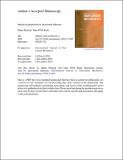Interfacial propulsion by directional adhesion
Author(s)
Prakash, Manu; Bush, John W. M.
DownloadBush_Interfacial propulsion.pdf (2.893Mb)
PUBLISHER_CC
Publisher with Creative Commons License
Creative Commons Attribution
Terms of use
Metadata
Show full item recordAbstract
The rough integument of water-walking arthropods is well-known to be responsible for their water-repellency [1], [2], [3] and [4]; however, water-repellent surfaces generally experience reduced traction at an air–water interface [5], [6], [7] and [8]. A conundrum then arises as to how such creatures generate significant propulsive forces while retaining their water-repellency. We here demonstrate through a series of experiments that they do so by virtue of the detailed form of their integument; specifically, their tilted, flexible hairs interact with the free surface to generate directionally anisotropic adhesive forces that facilitate locomotion. We thus provide new rationale for the fundamental topological difference in the roughness on plants and water-walking arthropods, and suggest new directions for the design and fabrication of unidirectional superhydrophobic surfaces.
Date issued
2010-12Department
Massachusetts Institute of Technology. Department of MathematicsJournal
International Journal of Non-Linear Mechanics
Publisher
Elsevier
Citation
Prakash, Manu, and John W.M. Bush. “Interfacial Propulsion by Directional Adhesion.” International Journal of Non-Linear Mechanics 46, no. 4 (May 2011): 607–615.
Version: Author's final manuscript
ISSN
00207462